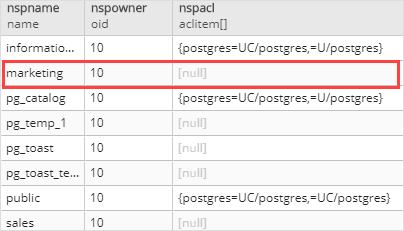PostgreSQL CREATE SCHEMA
Summary: in this tutorial, you will learn how to use the PostgreSQL CREATE SCHEMA statement to create a new schema in a database.
Introduction to PostgreSQL CREATE SCHEMA statement
The CREATE SCHEMA statement allows you to create a new schema in the current database.
The following illustrates the syntax of the CREATE SCHEMA statement:
CREATE SCHEMA [IF NOT EXISTS] schema_name;In this syntax:
- First, specify the name of the schema after the
CREATE SCHEMAkeywords. The schema name must be unique within the current database. - Second, optionally use
IF NOT EXISTSto conditionally create the new schema only if it does not exist. Attempting to create a new schema that already exists without using theIF NOT EXISTSoption will result in an error.
Note that to execute the CREATE SCHEMA statement, you must have the CREATE privilege in the current database.
You can also create a schema for a user:
CREATE SCHEMA [IF NOT EXISTS]
AUTHORIZATION username;In this case, the schema will have the same name as the username.
PostgreSQL allows you to create a schema and a list of objects such as tables and views using a single statement as follows:
CREATE SCHEMA schema_name
CREATE TABLE table_name1 (...)
CREATE TABLE table_name2 (...)
CREATE VIEW view_name1
SELECT select_list FROM table_name1;Notice that each subcommand does not end with a semicolon (;).
PostgreSQL CREATE SCHEMA statement examples
Let’s take some examples of using the CREATE SCHEMA statement.
1) Basic CREATE SCHEMA statement example
The following statement uses the CREATE SCHEMA statement to create a new schema named marketing:
CREATE SCHEMA marketing;The following statement returns all schemas from the current database:
SELECT *
FROM pg_catalog.pg_namespace
ORDER BY nspname;This picture shows the output:

2) Using CREATE SCHEMA statement to create a schema for a user example
First, create a new role with named john:
CREATE ROLE john
LOGIN
PASSWORD 'Postgr@s321!';Second, create a schema for john:
CREATE SCHEMA AUTHORIZATION john;Third, create a new schema called doe that will be owned by john:
CREATE SCHEMA IF NOT EXISTS doe AUTHORIZATION john;3) Using CREATE SCHEMA statement to create a schema and its objects example
The following example uses the CREATE SCHEMA statement to create a new schema named scm. It also creates a table named deliveries and a view named delivery_due_list that belongs to the scm schema:
CREATE SCHEMA scm
CREATE TABLE deliveries(
id SERIAL NOT NULL,
customer_id INT NOT NULL,
ship_date DATE NOT NULL
)
CREATE VIEW delivery_due_list AS
SELECT ID, ship_date
FROM deliveries
WHERE ship_date <= CURRENT_DATE;Summary
- Use the PostgreSQL
CREATE SCHEMAstatement to create a new schema in a database.